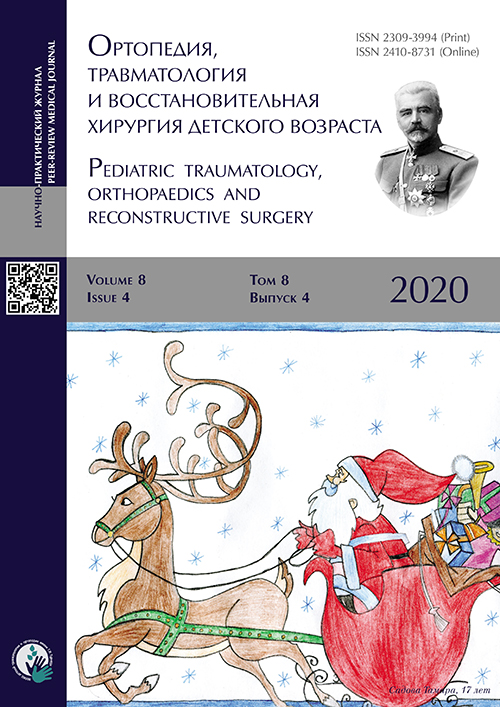Предварительные результаты хирургического лечения сгибательно-приводящей контрактуры трапециевидно-пястного сустава кисти в сочетании с вывихом в пястно-фаланговом суставе у пациентов с детским церебральным параличом
- Авторы: Умнов Д.В.1, Умнов В.В.1, Новиков В.А.1, Савина М.В.1
-
Учреждения:
- Федеральное государственное бюджетное учреждение «Национальный медицинский исследовательский центр детской травматологии и ортопедии имени Г.И. Турнера» Министерства здравоохранения Российской Федерации
- Выпуск: Том 8, № 4 (2020)
- Страницы: 417-426
- Раздел: Оригинальные исследования
- Статья получена: 25.08.2020
- Статья одобрена: 01.12.2020
- Статья опубликована: 09.01.2021
- URL: https://journals.eco-vector.com/turner/article/view/43115
- DOI: https://doi.org/10.17816/PTORS43115
- ID: 43115
Цитировать
Аннотация
Обоснование. Хирургические методы лечения сгибательно-приводящей контрактуры первого запястно-пястного сустава кисти в сочетании с вывихом в пястно-фаланговом суставе у больных детским церебральным параличом делятся на оперативные вмешательства на мягких тканях и на костные операции, направленные на стабилизацию пястно-фалангового сустава. Нами разработана методика временного артродеза пястно-фалангового сустава в сочетании с уже применявшейся ранее операцией по расширению первого межпястного промежутка, объединяющая положительные эффекты обеих групп операций: стабильность артродеза при установленной металлической конструкции с возможностью выполнения активных движений в суставе в достаточной амплитуде после ее удаления, а также ранняя послеоперационная реабилитация на фоне стабилизированного сустава.
Цель — оценка эффективности нового метода хирургической коррекции сгибательно-приводящей контрактуры трапециевидно-пястного сустава кисти в сочетании с вывихом в пястно-фаланговом суставе у пациентов с детским церебральным параличом.
Материалы и методы. Проанализированы результаты лечения больных (n = 11), которым сформирован временный артродез пястно-фалангового сустава накостной пластиной на срок один год и устранена сгибательно-приводящая контрактура запястно-пястного сустава. Сравнительный анализ результатов проводили через 6 мес. и через год после выполнения операции, а также в среднем через 2 мес. после удаления металлоконструкции (от 1 до 4 мес.). Анализировали амплитуду пассивных и активных движений в пястно-фаланговом суставе. Оценивали по международной системе классификации MACS 2002 г. и Block and Box test функциональные возможности верхней конечности. Кроме того, с целью исследования функционального состояния мышц, прежде всего определяющих эффективность цилиндрического схвата, проведено обследование с использованием поверхностной электромиографии на четырехканальном электронейромиографе фирмы «Нейрософт» (Россия).
Результаты. Через год после оперативного вмешательства и удаления фиксирующей конструкции отмечено как увеличение амплитуды пассивного отведения (на 32,0°) и разгибания (на 9,5°) в запястно-пястном суставе, так и увеличение амплитуды тех же движений (отведения на 25,5° и разгибания на 4,0°), выполнявшихся активно. Показатель MACS улучшился на 1 балл. Средняя динамика Block and Box test составила 7 дополнительных кубиков. После удаления через год металлоконструкции в течение в среднем 2 мес. (максимальный срок — 4 мес.) пястно-фаланговый сустав оставался стабильным при амплитуде сгибания 10–20°.
Заключение. Разработанная методика временного внесуставного артродеза пястно-фалангового сустава не затрагивает внутрисуставные структуры в отличие от внутрисуставного артродеза, а значит, обладает явными преимуществами перед последним. Данный способ хирургического лечения эффективен в отношении увеличения амплитуды активных и пассивных движений первого запястно-пястного сустава. За время наблюдения в среднем в течение 2 мес. после удаления пластины пястно-фаланговый сустав оставался стабильным.
Полный текст
Об авторах
Дмитрий Валерьевич Умнов
Федеральное государственное бюджетное учреждение «Национальный медицинский исследовательский центр детской травматологии и ортопедии имени Г.И. Турнера» Министерства здравоохранения Российской Федерации
Автор, ответственный за переписку.
Email: dmitry.umnov@gmail.com
ORCID iD: 0000-0003-4293-1607
канд. мед. наук, научный сотрудник отделения детского церебрального паралича
Россия, Санкт-ПетербургВалерий Владимирович Умнов
Федеральное государственное бюджетное учреждение «Национальный медицинский исследовательский центр детской травматологии и ортопедии имени Г.И. Турнера» Министерства здравоохранения Российской Федерации
Email: umnovvv@gmail.com
ORCID iD: 0000-0002-5721-8575
д-р мед. наук, ведущий научный сотрудник отделения детского церебрального паралича
Россия, Санкт-ПетербургВладимир Александрович Новиков
Федеральное государственное бюджетное учреждение «Национальный медицинский исследовательский центр детской травматологии и ортопедии имени Г.И. Турнера» Министерства здравоохранения Российской Федерации
Email: novikov.turner@gmail.com
ORCID iD: 0000-0002-3754-4090
канд. мед. наук, научный сотрудник отделения детского церебрального паралича
Россия, Санкт-ПетербургМаргарита Владимировна Савина
Федеральное государственное бюджетное учреждение «Национальный медицинский исследовательский центр детской травматологии и ортопедии имени Г.И. Турнера» Министерства здравоохранения Российской Федерации
Email: drevma@yandex.ru
ORCID iD: 0000-0001-8225-3885
канд. мед. наук, руководитель лаборатории физиологических и биомеханических исследований
Россия, Санкт-ПетербургСписок литературы
- Бадалян Л.О. Детская неврология. – М.: Медпресс-информ, 2001. [Badalyan LO. Detskaya nevrologiya. Moscow: Medpress-inform; 2001. (In Russ.)]
- House JH, Gwathmey F, Fidler M. A dynamic approach to the thumb-in-palm deformity in cerebral palsy. J Bone Joint Surg Am. 1981;63(2):216-225.
- Miller F. Cerebral palsy. New York: Springer; 2005.
- Новиков В.А., Умнов В.В. Хирургическое лечение сгибательно-приводящей контрактуры первого пальца кисти у детей с детским церебральным параличом // Ортопедия, травматология и восстановительная хирургия детского возраста. – 2015. – Т. 3. – № 2. – С. 25–31. [Novikov VA, Umnov VV. Surgical treatment of thumb adduction contracture in children with infantile cerebral palsy. Pediatric Traumatology, Orthopaedics and Reconstructive Surgery. 2015;3(2):25-31. (In Russ.)]. https://doi.org/10.17816/PTORS3225-31.
- Özkan T, Tunçer S. Tendon transfers for the upper extremity in cerebral palsy. Acta Orthop Traumatol Turc. 2009;43(2):135-148. https://doi.org/10.3944/AOTT.2009.135.
- Tranchida GV, Van Heest AE. Outcomes after surgical treatment of spastic upper extremity conditions. Hand Clin. 2018;34(4):583-591. https://doi.org/10.1016/j.hcl. 2018.06.014.
- Lawson RD, Tonkin MA. Surgical management of the thumb in cerebral palsy. Hand Clin. 2003;19(4):667-677. https://doi.org/10.1016/s0749-0712(03)00042-8.
- Tonkin M, Freitas A, Koman A, et al. The surgical management of thumb deformity in cerebral palsy. J Hand Surg Eur Vol. 2008;33(1):77-80. https://doi.org/10.1177/1753193407087891.
- Smeulders M, Coester A, Kreulen M. Surgical treatment for the thumb‐in‐palm deformity in patients with cerebral palsy. Cochrane Database Syst Rev. 2005;19(4):CD004093. https://doi.org/10.1002/14651858.CD004093.pub2.
- Goldner JL, Koman LA, Gelberman R, et al. Arthrodesis of the metacarpophalangeal joint of the thumb in children and adults: Adjunctive treatment of thumb-in-palm deformity in cerebral palsy. Clin Orthop Relat Res. 1990;(253):75-89.
Дополнительные файлы


















